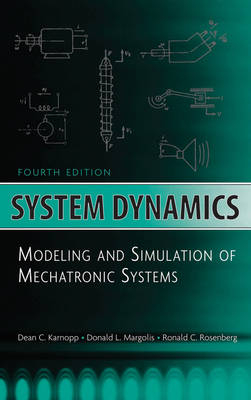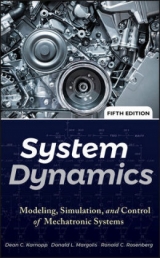
System Dynamics
John Wiley & Sons Inc (Verlag)
978-0-471-70965-7 (ISBN)
- Titel ist leider vergriffen;
keine Neuauflage - Artikel merken
The new edition incorporates the authors' vast experience in teaching the topics to undergraduate and graduate students over many years and features expanded coverage of topics including: New expositions of modeling methods for electrical, mechanical, and hydraulic systems New sections on mechanical systems in plane and three-dimensional motion New sections on hydraulic and acoustic systems This Fourth Edition continues to stress all the essentials-from basic hand formulation of simple bond graph models to the automatic simulation of complex mechatronic systems. It offers updated examples of multi-energy domain systems as well as: Discussions of state-of-the-art simulation software for use with bond graph models Presentations of a multiport modeling philosophy based on power and energy interactions Methods for understanding system characteristics and predicting system behaviors The use of graphical depictions of dynamic systems that can be translated automatically into complex mathematical models for computer simulation
DEAN C. KARNOPP and DONALD L. MARGOLIS are Professors of Mechanical Engineering at the University of California, Davis. RONALD C. ROSENBERG is Professor of Mechanical Engineering at Michigan State University.
Preface. 1 Introduction. 1.1 Models of Systems. 1.2 Systems, Subsystems, and Components. 1.3 State-Determined Systems. 1.4 Uses of Dynamic Models. 1.5 Linear and Nonlinear Systems. 1.6 Automated Simulation. References. Problems. 2 Multiport Systems and Bond Graphs. 2.1 Engineering Multiports. 2.2 Ports, Bonds, and Power. 2.3 Bond Graphs. 2.4 Inputs, Outputs, and Signals. Problems. 3 Basic Component Models. 3.1 Basic 1-Port Elements. 3.2 Basic 2-Port Elements. 3.3 The 3-Port Junction Elements. 3.4 Causality Considerations for the Basic Multiports. 3.4.1 Causality for Basic 1-Ports. 3.4.2 Causality for Basic 2-Ports and 3-Ports. 3.5 Causality and Block Diagrams. 3.6 Pseudo-Bond Graphs and Thermal Systems. Reference. Problems. 4 System Models. 4.1 Electrical Systems. 4.1.1 Electrical Circuits. 4.1.2 Electrical Networks. 4.2 Mechanical Systems. 4.2.1 Mechanics of Translation. 4.2.2 Fixed-Axis Rotation. 4.2.3 Plane Motion. 4.3 Hydraulic and Acoustic Circuits. 4.3.1 Fluid Resistance. 4.3.2 Fluid Capacitance. 4.3.3 Fluid Inertia. 4.3.4 Fluid Circuit Construction. 4.3.5 An Acoustic Circuit Example. 4.4 Transducers and Multi-Energy-Domain Models. 4.4.1 Transformer Transducers. 4.4.2 Gyrator Transducers. 4.4.3 Multi-Energy-Domain Models. References. Problems. 5 State-Space Equations and Automated Simulation. 5.1 Standard Form for System Equations. 5.2 Augmenting the Bond Graph. 5.3 Basic Formulation and Reduction. 5.4 Extended Formulation Methods-Algebraic Loops. 5.4.1 Extended Formulation Methods-Derivative Causality. 5.5 Output Variable Formulation. 5.6 Automated and Nonlinear Simulation. 5.6.1 Nonlinear Simulation. 5.6.2 Automated Simulation. Reference. Problems. 6 Analysis of Linear Systems. 6.1 Introduction. 6.2 Solution Techniques for Ordinary Differential Equations. 6.3 Free Response and Eigenvalues. 6.3.1 A First-Order Example. 6.3.2 Second-Order Systems. 6.3.3 Example: The Undamped Oscillator. 6.3.4 Example: The Damped Oscillator. 6.3.5 The General Case. 6.4 Forced Response and Frequency Response Functions. 6.4.1 Normalization of Response Curves. 6.4.2 The General Case. 6.5 Transfer Functions. 6.5.1 Block Diagrams. 6.6 Total Response. 6.7 Alternative State Variables. References. Problems. 7 Multiport Fields and Junction Structures. 7.1 Energy-Storing Fields. 7.1.1 C-Fields. 7.1.2 Causal Considerations for C-Fields. 7.1.3 I-Fields. 7.1.4 Mixed Energy-Storing Fields. 7.2 Resistive Fields. 7.3 Modulated 2-Port Elements. 7.4 Junction Structures. 7.5 Multiport Transformers. References. Problems. 8 Transducers, Amplifiers, and Instruments. 8.1 Power Transducers. 8.2 Energy-Storing Transducers. 8.3 Amplifiers and Instruments. 8.4 Bond Graphs and Block Diagrams for Controlled Systems. References. Problems. 9 Mechanical Systems with Nonlinear Geometry. 9.1 Multidimensional Dynamics. 9.2 Kinematic Nonlinearities in Mechanical Dynamics. 9.2.1 The Basic Modeling Procedure. 9.2.2 Multibody Systems. 9.2.3 Lagrangian or Hamiltonian IC-Field Representations. 9.3 Application to Vehicle Dynamics. References. Problems. 10 Distributed-Parameter Systems. 10.1 Simple Lumping Techniques for Distributed Systems. 10.2 Lumped Models of Continua through Separation of Variables. 10.3 General Considerations of Finite-Mode Bond Graphs. 10.4 Assembling Overall System Models. 10.5 Summary. References. Problems. 11 Magnetic Circuits and Devices. 11.1 Magnetic Effort and Flow Variables. 11.2 Magnetic Energy Storage and Loss. 11.3 Magnetic Circuit Elements. 11.4 Magnetomechanical Elements. 11.5 Device Models. References. Problems. 12 Thermofluid Systems. 12.1 Basic Thermodynamics in Bond Graph Form. 12.2 Heat Transfer in True Bond Graphs and Pseudo-Bond Graphs. 12.2.1 A Simple Example. 12.2.2 An Electrothermal Resistor. 12.3 Fluid Dynamic Systems. 12.3.1 One-Dimensional Incompressible Flow. 12.3.2 Representation of Compressibility Effects. 12.3.3 Inertial and Compressibility Effects in One-Dimensional Flow. 12.4 Pseudo-Bond Graphs for Compressible Gas Dynamics. 12.4.1 The Thermodynamic Accumulator. 12.4.2 The Isentropic Nozzle. 12.4.3 Constructing Models with the Thermodynamic Accumulator and Isentropic Nozzle. 12.4.4 Summary. References. Problems. 13 Nonlinear System Simulation. 13.1 Explicit First-Order Differential Equations. 13.2 Differential Algebraic Equations Caused by Algebraic Loops. 13.3 Implicit Equations Caused by Derivative Causality. 13.4 Automated Simulation of Dynamic Systems. 13.4.1 Sorting of Equations. 13.4.2 Implicit and Differential Algebraic Equation Solvers. 13.4.3 Icon-Based Automated Simulation. 13.5 Example Nonlinear Simulation. 13.5.1 Some Simulation Results. 13.6 Conclusions. References. Problems. Appendix. Index.
| Erscheint lt. Verlag | 20.1.2006 |
|---|---|
| Zusatzinfo | Illustrations |
| Verlagsort | New York |
| Sprache | englisch |
| Maße | 163 x 238 mm |
| Gewicht | 965 g |
| Einbandart | gebunden |
| Themenwelt | Technik ► Maschinenbau |
| ISBN-10 | 0-471-70965-4 / 0471709654 |
| ISBN-13 | 978-0-471-70965-7 / 9780471709657 |
| Zustand | Neuware |
| Haben Sie eine Frage zum Produkt? |
aus dem Bereich



